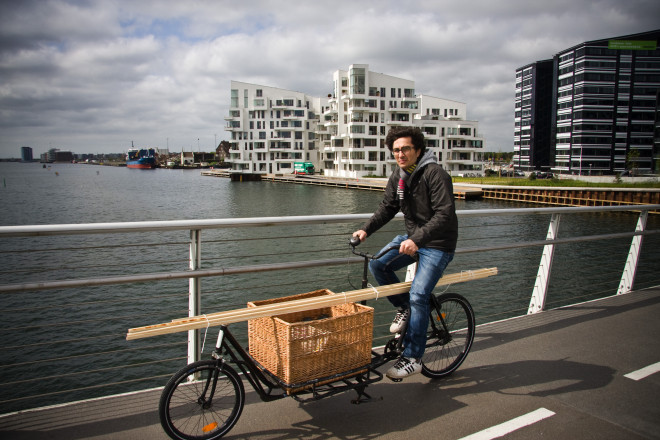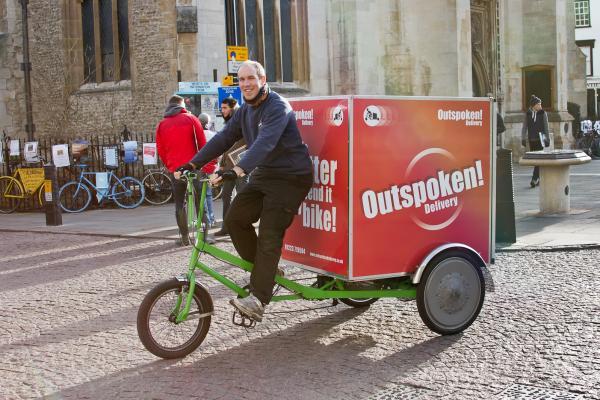
Cargo Bike Crazy: The Potential of Delivering Goods By Bike
Is it Cargo Bicycle O'Clock? ECF believes current urban conditions are perfect for moving more goods by cycle. Last month, we crunched some numbers and case studies for Eltis, Europe's leading urban mobility portal. Here's what we came up with...
When it comes to urban delivery, the first and last mile is a major headache. It’s expensive, it’s congested, and in urban areas, logistic companies have to fight for limited space. In city centres most goods reach their final destination in motorised cars, vans and trucks. Even light goods are often moved by heavy vehicles over very short distances.
The cycling world has a solution. According to the EU funded CYCLE logistics project, 25% of all goods and 50% of all light goods could be moved by cycle in urban areas[1]. But before looking at cargo bicycle solutions, one must first ask the question, what will the city of 2050 look like?
EU Trends in Cities
Cities in 2050 are not going to be welcoming to urban logistic companies who keep using conventional motor vehicles. It is going to be either impossible or very expensive to get around urban areas with vans and trucks.
Congestion is already damaging our economies by wasting 3% of GDP in OECD countries. The global transport body, the International Transport Forum (ITF), is predicting that passenger mobility will increase by 300-400%[2]. As it currently stands, 10-18% of road traffic is represented by goods transport[3]. This means there will be a conflict over urban space. It also means that delivery fleets will be competing with passenger transport for access to road infrastructure and parking.
Global trends indicate an EU-wide increase in cyclists on the roads, with 35 million Europeans citing cycling as their main mode of transport[4]. Nearly 70 cities in Europe have signed the charter of Brussels, calling for a 15% cycling modal share across Europe[5]. This will mean more than 70 million cyclists on EU roads, which urban logistics will have to compete with for public space.
Trucks: Politically Unpalatable
Adding to congestion woes is the fact that trucks and lorries are becoming unpopular among policy makers and politicians. Besides causing congestion, pollution and wear and tear on roads, they are involved in accidents resulting in the death of cyclists.
- There are some alarming facts and figures:
- Trucks make up 3% of EU road traffic, yet they are responsible for 14% of fatal collisions[6].
- In London, half of all cyclist fatalities are caused by trucks[7].
- In the cycling haven of the Netherlands, one third of accidents involving severely injured cyclists are collisions with lorries[8].
- In the EU, 50,000 people die prematurely and 200,000 suffer from cardiovascular disease each year because of traffic noise[9].
- Reducing noise levels would save €89 billion in health costs by 2030, cut €8 billion off insulation costs and add €229 billion to the property value[10]
As a result, authorities are increasingly looking towards reducing freight traffic within inner cities and urban areas. Current trends in Europe signify that the urban realm is becoming human-oriented. City centres are increasingly being closed off to delivery vans, if not subject to congestion charges or other regulations which add significant economic burdens on urban logistics.
There are number of European policies which point to this[11]:
- Vehicles are being restricted from entering areas using ‘eco-zoning’ where only low-emission vehicles can enter certain areas. This is applied, for example, inAmsterdam (the Netherlands), Nuremburg (Germany) and Zermatt (Switzerland).
- In Belgium, Brussels is investigating banning heavy goods vehicles from the city centre, and both Antwerp and Brussels have banned trucks from some of their urban roads.
- In the Czech Republic, Prague has restricted access to the city centre from Monday to Friday (08:00-18:00) for certain delivery vehicles, and introduced a total ban on delivery vehicles weighing over 6.5 tonnes.
- Milan, London and Stockholm have all implemented congestion charges whereby motorised vehicles must pay to access city centres.
- In Denmark, new environmental legislation allows municipalities to ban heavy delivery vehicles, with for example the municipality of Aarhus planning to ban heavy delivery vehicles. In Copenhagen, a compulsory certification scheme has been introduced in the medieval city centre with capacity utilisation and engine technology requirements.
- In the United Kingdom, Cambridge has been blocking access to the city centre for all motorised vehicles (10:00-16:00) with the use of mechanised bollards. London has congestion charges in place.
- In Spain, Barcelona only allows motorised vehicles into the city centre if they have a special smart card, with delivery vehicles banned during certain times. The system has digital video enforcement.
- In Germany, environmental legislation allows cities to ban or reduce freight traffic due to air pollution, with talk of limiting city access for trucks between 10:00 and 16:00 inStuttgart. Bremen, Cottbus, Düsseldorf and Dortmund have been limiting freight traffic only along specified routes.
- In Sweden, the cities of Stockholm, Gothenburg, Malmö and Lund have implemented environmental zones: Vehicles over 3.5 tonnes (total weight), and over eight years old are forbidden from entering these areas.
- In Europe, the European Commission has called for essentially CO2-free city logistics in major urban centres by 2030.[12]
Cost of Business
Even in areas where city centres are accessible, using vans and trucks for delivery is becoming increasingly expensive. In Canada, in 2006 alone, three major express delivery companies (FedEx, United Parcel Service and Purolator) were awarded 34,000 parking tickets amounting to approximately $1.5 million in fines[13]. In the London Boroughs of Westminster and Camden, TNT reported that it was facing £300,000 per annum in fines[14]. Congestion charges in London alone will also cost TNT Express Services an average of £15,000 a month[15]. In total, TNT will have to absorb £250,000 a year in charges if London extends its congestion zone.
Working With the Trend: Cargo Cycles
Cargo bicycles may just prove to be the solution to these problems. Research by the German Institute of Transport found that e-cargo bikes could take care of 85% of deliveries in Berlin. Similar studies in Breda (the Netherlands) have found that of the 1,900 trucks that go in everyday, less than 10% of the cargo being delivered requires a truck and 40% of deliveries involve one box. It would appear that cargo cycles can help freight companies rid themselves of unnecessary motorised delivery trips within the supply chain.
Within urban areas, cargo cycle companies are also offering services which are generally cheaper and often able to deliver using the same time frame. In April, 2012, the Cambridge based delivery company ‘Outspoken Delivery’ was able to deliver 17,000 magazines to 430 locations in 2 days for a total cost of €800[16]. No other motorised service provider was able to do so at a comparable cost.
Another reason companies are using cargo cycle delivery is because it is reliable. A report from the International Transport Forum found that the costs of unreliability may rival those of congestion[17]. The majority of clients using such services do so because they say they are certain that it can get there on time. Companies such as TNT, KMPG, Ernst and Young, Phillips and Fed-EX have already started integrating cycle companies into the delivery chain for this very reason.
Package size is also getting increasingly smaller. Retail giant FNAC has stated that the average package size for internet orders is approximately 500 grams[18], making cycles the perfect solution for last mile delivery. Global e-commerce sales will reach $963 billion by 2013, growing at an annual rate of 19.4%[19]. By 2014, e-commerce will increase by 90%.
New Products
The bicycle industry is also developing products which can shift high volumes of cargo in urban areas. Cargo cycles these days are capable of carrying a payload of more than 250 kilos. This is more than just pizza delivery. These bicycles can deliver everything: from expensive electronic equipment to refrigerated test tube vials to important legal documents. In Copenhagen, there are even “Sperm Bicycles” capable of delivering sperm donations across the city.
The French company La Petite Reine is able to move over one million packages annually with 60 cargo bicycles all over France, from Lyon, Bordeaux, Rouen, Lyon and Geneva, Switzerland. France’s national railway company, SNCF, has invested half a million euro in a company called Urban Cab so that it can provide a cost-effective solution to the last-mile dilemma, and are developing cargo bicycles accordingly.
Delivery Methods
So how do you get goods out of trucks and onto bicycles? “Outspoken Delivery” from Cambridge has developed a delivery model[20].
Using their office/workshop as a hub, companies drop off their deliveries (up to 25kg) for the inner city centre early in the morning. Throughout the day, Outspoken Delivery can deliver the ‘last mile’ using their range of freight bicycles. This proves ideal in a city like Cambridge where delivery vans are not allowed in the city from 10am to 4pm.

The eventual vision is to have these hubs strategically located throughout the city with delivery by van or lorry to hubs on the major roads surrounding the city, such as Park & Ride sites. From there, the ‘last mile’ will be delivered by a range of bicycles and electric vehicles. The bigger freight bicycles can also act as mobile hubs, allowing the smaller freight bikes to carry out deliveries in specified areas.
There is also another approach adopted by Urban Cab, a company based in Paris, France.
Suppliers have all their goods pre-sorted at logistic centres and then packed into containers which fit onto specially designed bicycles. These containers are transported to the edge of the city, scanned and loaded onto the back of bicycles for the quickest, most efficient routing, effectively avoiding any resorting of goods.

Last year, Urban Cab was also developing a system allowing customers to choose a fixed location at various points across the city to pick up their goods. The bicycles simply park (for free) in a fixed location, saving customers the hassle of having to be at home when their goods are delivered.
What is clear is that new delivery models are likely to arise as more and more companies take to using cargo bicycles to deliver. This year more than 30 companies from across Europe have launched a European Cycle Logistics Federation (ECLF), aimed at improving urban bike deliveries and lobbying for cycle-based delivery policies.
It would appear that the future for deliveries by cycle is bright indeed.
 About the Author
About the Author
Julian Ferguson is the Communications Officer for the European Cyclists’ Federation. Originally hailing from Australia and a keen bicycle advocate, he plans one day to ride his bicycle from Brussels to Melbourne
This article originally appeared on Eltis- The Urban Mobility Portal.
Further Reading
- The Cycle Logistics Project: www.cyclelogistics.eu
- Cargo Bicycle Fact Sheet: http://ecf.com/files/wp-content/uploads/Factsheet-ITF2012-CLOG.pdf
References [1]
Cycle Logistics Internal Report, 2012, www.cyclelogistics.eu
[2] International Transport Forum, 2011,http://www.internationaltransportforum.org/Pub/pdf/11Outlook.pdf
[3] United Nations, 2010,http://www.unescap.org/ttdw/common/TPT/egm_eco_efficiency/dr_wisinee.pdf
[4] Euro Barometer, 2011, http://ec.europa.eu/public_opinion/flash/fl_312_en.pdf
[5] European Cyclists’ Federation, 2012, http://ecf.com/manifesto/charter-of-brussels/
[6] European Cyclists Federation, 2012, http://ecf.com/news/eu-commission-to-update-legislation-on-megatrucks/
[7] Transport for London, 2012,http://www.tfl.gov.uk/microsites/freight/hgvs_and_road_safety.aspx
[8] Dutch Institute for Road Safety Research, 2009,http://www.swov.nl/rapport/Factsheets/UK/FS_Blind_spot_crashes.pdf
[9] Transport and Environment, 2012,http://www.transportenvironment.org/publications/traffic-noise-reduction-europe
[10] Ibid
[11] International Transport Forum, 2012,http://www.internationaltransportforum.org/pub/pdf/03DeliveringGoods.pdf
[12] COM(2011) 144 final, Roadmap to a Single European Transport Area – Towards a competitive and resource efficient transport system
[13] Ryerson University, 2009,https://canadiancourier.org/uploads/Challenges_Facing_Express_Delivery_Services_in_Canada_s_Urban_Centres.pdf
[14] TNT, 2011http://www.tnt.com/express/en_gb/site/home/about_us/about_tnt_express/industries_and_markets/parking_fines.html
[15] Ibid, 2011,http://www.tnt.com/express/en_gb/site/home/about_us/about_tnt_express/industries_and_markets/congestion_charging.html
[16] As expressed via phone interview with Outspoken Delivery
[17] International Transport Forum 2012,http://www.internationaltransportforum.org/jtrc/PolicyBriefs/PDFs/2012-04-18.pdf
[18] Figures expressed in an interview with Urban Cab Delivery
[19] Goldman Sachs, 2011, http://resources.pbecomm.com/blog/global-ecommerce-market-stats-blog/goldman-sachs-forecasts-growth-rate-of-global-e-commerce-sales-asia-factors-big/
[20] Outspoken Delivery, 2012, http://www.outspokendelivery.co.uk/about-us/vision
Contact the author
Recent news!
Upcoming events
Contact Us
Avenue des Arts, 7-8
Postal address: Rue de la Charité, 22
1210 Brussels, Belgium













